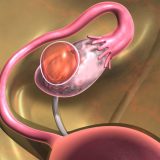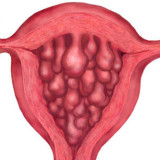Atheroma is a small cyst of the sebaceous gland (epidermal cyst). Most often it is located near the hair follicles and sebaceous glands. That’s why atheromas are usually appear on the head.
The formation, no matter where it is located, has the form of a lump. It contains thick and calloused epidermis, and in some cases hair follicles.
This tumor is located in the skin. Usually atheroma has a flesh color, often with a slightly yellowish tint, sometimes it can also have a white color. It happens that the dark spot can be seen on the cyst surface – it is a hair follicle. The formations are usually soft, although they can also have a moderately firm consistency.
Atheroma is most often found in people aged 30 to 40 years. Also teenagers often faced with it during puberty, when there are significant hormonal changes, and the changes in the functioning of the sebaceous glands.
Men have such cysts twice more often than women.
Does atheroma hurt?
In the beginning the patient does not feel any discomfort, and the skin around the atheroma has no signs of inflammation.
However, in case of infection inside the cyst, pain and discomfort may occur. The purulent contents begin to accumulate inside, and the skin around the atheroma is red and inflamed.
Causes
Different types of hair follicles defects can cause such formations. Hair follicles damage, in its turn, can be caused by various types of injuries, abrasions. In addition, sometimes genetic predisposition play significant role in atheromas development because of their relatively frequent occurrence in the family. Different types of cosmetics, which are incorrectly selected for the skin type, contribute to the “blockage” of hair follicles and sebaceous glands.
 1 – cavity with waxy-oil content
1 – cavity with waxy-oil content
2 – capsule
3 – the blocked duct of the sebaceous gland
4 – skin
5 – subcutaneous skin
The defect of the hair follicle
Due to various skin injuries, abrasions or postoperative wounds, the hair follicle cells are damaged and tangles are formed.
Genetic
People with the the particular state of cells and hair follicles because of genetic are at increased risk of developing atheromas. Patients with rare genetic Gardner’s disease are also at risk of its developing.
Everyday life
Atheroma can also be caused by excessive skin exposure to ultraviolet radiation, it is mainly about the elderly after 65 years. Some oil-based creams can also play a role in the occurrence of such kind of cysts, excessive using of them adversely affects the skin and leads to blockage of the sebaceous glands and the cyst formations.
Diagnosis
The doctor usually can diagnose atheroma at the doctor appointment with palpation. However, if the doctor has any doubts, he can always refer the patient to medical ultrasound or histological examination to make an accurate diagnosis.
Formation on the skin may also be:
- neurofibroma – cutaneous lesions often has multiple character,
- abscesses and inflammations,
- lipoma – a soft to palpation and has a tendency to increase.
A large number of epidermoid cysts on tennagers’ skin may indicate the presence of Gardner’s syndrome. It is a genetic disease inherited by an autosomal dominant.
Treatment
As a rule, atheroma do not require any treatment. Usually it disappears by its own as a result of the rupture and the subsequent content flowing out. This can be contributed from regular peels or puncture. To avoid infection in the sebaceous gland, it is necessary to choose the right antibiotic.
Atheroma can be unacceptable for the patient from cosmetological point of view, or bring problems in everyday life. For example, when visiting a hairdresser. In this case the surgery is necessary. And after consultation with the doctor, such kind of cyst can be removed surgically.
Another method of atheroma treatment is cryotherapy(freezing). During the procedure the tissue is destroyed. This method is non-invasive and is made locally.
If the sebaceous gland cyst has inflammation, it is pierced with injections of glucocorticosteroids or antibiotics or steroids are recommended. After this procedure (about six weeks), the atheroma is removed, and the skin is suture. The summa should be removed after about two weeks.
In a situation where the atheroma is in a very sensitive place, doctors use a laser procedure with carbon dioxide.
Home method – compress decoction of horsetail, which relieves irritation and has a beneficial effect on the sebaceous glands. It requires:
- 2 cups of water;
- cotton wool and bandage;
- four spoons of horsetail.
Let the infusion stand for about five minutes, then get the fleece wet and put in the atheroma place.
Attention! Do not puncture / do not remove / do not squeeze the atheroma by your own! It can cause infection.
How to prevent atheromas
First of all, you should take care of personal hygiene and systematically exfoliate the horny epidermis with peelings. As a result, hair follicle obstruction can be avoided.
If you have problem skin, do not hesitate to attend the specialist. Correctly chosen by a dermatologist or a surgeon treatment allows to avoid infections, atheromas and malignant tumors.












